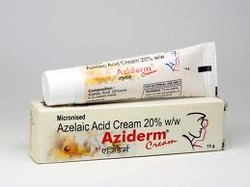Azelaic acid
What is it?
Azelaic acid is an organic compound exists as a white powder in barley, wheat, and rye. It is parts of a number of skin and hair conditioners. It is the second choice in treatments of acne next to benzoyl peroxide and retinoids. It is usually used when other treatment options such as benzoyl peroxide and retinoids are not effective.
It is labeled for the treatment of mild to moderate inflammatory and comedonal acne. The way it works to treat acne is by killing any acne bacteria that infect skin pores. In addition, it minimizes keratin production that enhance the growth of acne bacteria. Azelaic-acid has the ability to reduce inflammation, as a result, it is used as a topical gel treatment for acne rosacea.
Why Azelaic acid?
- It is a best antibacterial that has the capacity to stop the development of bacteria from the skin pores and follicles.
- It also lowers the formation of blackheads and whiteheads
- It can reducing the swelling and inflammation of the skin by avoiding toxins in the skin.
The acid can cause skin dryness, irritation, itching and discoloration. This condition is common when a person begin the treatment for the first time, however, it reduces after a while. Individuals who are gluten sensitivity should avoid using azelaic-acid because the compound exists as a white powder that is found in rye, barley and wheat.
How should azelaic acid be used?

Usually, azelaic-acid administered topically as a cream and gel and is it is applied twice a day, in the morning and the evening. Follow the direction on the label, if you do not understand, call your doctor and discuss about it. By any means do not exceed the prescribed amount while you are using.
Use of this ingredient does not cure acne, but it helps to control the breakout. You might not notice much improvement at the beginning, so continue to use it for at least 4 weeks or more as it takes time to get the full benefit.
Steps to follow
- Clean the affected area with water and a mild soap or cleanser and dry it with soft towel. Do not use alcoholic cleansers.
- Apply a thin layer of gel or cream to the affected area and massage gently.
- Avoid contact with your eyes or mouths. If you do get azelaic-acid in to your eyes or mouth, rinse it with water. If the irritating situation continue, contact your physician.
- Avoid to cover the affected skin with any dressing or bandages.
- Clean your hands with water and soap after you finish applying the medication.
Side effects
- Azelaic acid has several side effects like other topical treatments. After you have started applying this treatment, it is common for skin to feel dry, turn red, itch and peel during the first few weeks. However, it is possible to minimise such adverse effect through gradual introduction of the treatment to your skin.
- The itching and redness can be avoided by applying the treatment on the dry skin. I.e. Clean your skin, dry, wait for half an hour and apply the treatment. Sometimes the cream base for azelaic-acid can aggravate blackheads and clogged pores, so contact dermatologist in such circumstance.
Irresistible Acne Remedies. This free newsletter is delivered monthly, straight to your INBOX. It covers all new pages since the last issue. Sign up here...


New! Comments
Have your say about what you just read! Leave me a comment in the box below.